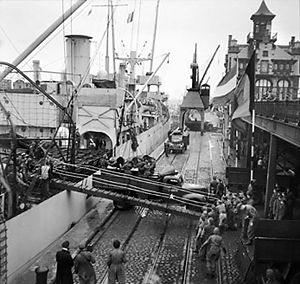SS Fort Cataraqui
 SS Fort Cataraqui in the port of Antwerp
| |
| History | |
|---|---|
| Name | Fort Catarqui |
| Builder | Davie Shipbuilding & Repair Company |
| Launched | 15 September 1942 |
| Acquired | October 1942 |
| Fate | Scrapped 1960 |
| General characteristics | |
| Tonnage |
|
| Length | 441 ft 6 in (134.57 m) |
| Beam | 57 ft 2 in (17.42 m) |
| Draught | 27 ft (8.2 m) |
| Propulsion |
|
| Speed | 11 knots (20 km/h; 13 mph) |
| Range | 11,400 nmi (21,100 km) at 10 kn (19 km/h; 12 mph) |
| Complement | 115 |
| Armament |
|
SS Fort Cataraqui was a North Sands-type Fort ship. The North Sands type, along with similar Park, Fort, and Canadian Liberty classes were essentially British and Canadian variants of the American Liberty and Victory classes. Fort Cataraqui is notable for being the first Allied ship to enter the port of Antwerp after the Canadian First Army cleared the Scheldt Estuary during the Battle of the Scheldt in the Second World War.
The vessel was built by Davie Shipbuilding & Repair Company, in Lauzon, Quebec and was delivered in October 1942. Fort Cataraqui survived the war and was broken up in 1960 in Mobile, Alabama.[1][2] During World War II, 28 were lost to enemy action, and four were lost due to accidents. Many of the surviving 166 ships passed to the United States Maritime Commission. The last recorded scrapping was in 1985,[3][4][5] and two ships, the former and , were listed on Lloyd's Register until 1992.[4]
See also[]
References[]
- ^ "'FORT', 'OCEAN' & 'PARK' TYPE SHIPS". Mariners. Retrieved 12 August 2014.
- ^ "The Forts". Angela DeRoy-Jones. Retrieved 13 August 2014.
- ^ "FORT SHIPS A - J". Mariners. Retrieved 12 August 2012.
- ^ a b "FORT SHIPS K - S". Mariners. Retrieved 12 August 2012.
- ^ "FORT SHIPS T - Y". Mariners. Retrieved 12 August 2012.
- World War II merchant ships of Canada
- 1942 ships
- Canadian naval ship stubs